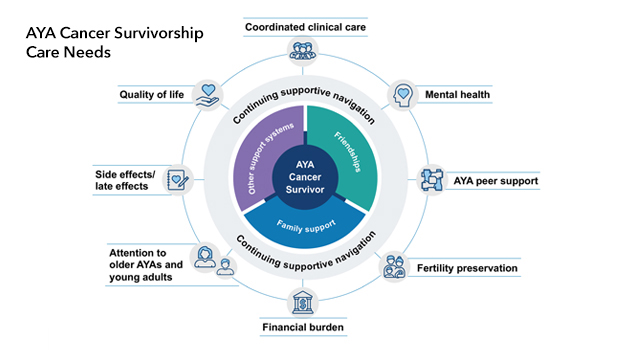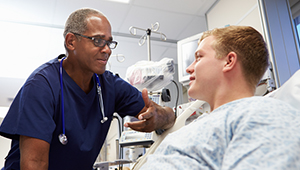Supporting young adults through cancer and beyond

A potential new care model for young cancer survivors centers patient needs, support networks
Adolescents and young adults who receive a cancer diagnosis have unique needs throughout treatment and afterward. A new study from researchers at Kaiser Permanente Washington Health Research Institute (KPWHRI) proposes a patient-centered care model for adolescent and young adult cancer survivors that focuses on the key themes and challenges that came from talking to people in this age group about their experiences.
“Adolescents are underrepresented in cancer care research, and most existing care models that we found focused on a specific aspect of care, like mental health or fertility concerns,” said Marlaine Figueroa Gray, PhD, a researcher at KPWHRI and lead author of the study. “Having done research with young adults living with cancer before, I’ve heard firsthand how hard it is to receive a cancer diagnosis and try to navigate the many intersecting challenges it brings. Cancer care is often geared toward older adults with different resources and concerns, and we wanted to figure out how to better support a younger age group.”
Conceptual models for care provide frameworks for understanding relationships that influence care and can be used to target care gaps or visualize possible changes. The researchers identified 8 key needs for adolescent and young adult cancer survivors (ages 15 to 39), which they included in a model that views cancer care as a cycle rather than a linear progression.
“For the people we spoke with, their experience wasn’t linear, and it lasted well beyond the period where they received treatment,” Figueroa Gray said. “This led us to design a model that looks at survivorship care as cyclical, where different needs intersect and recur at different points in time.”
The researchers emphasized the intersectional nature of different needs during treatment. For example, some interviewees pointed out that connection to peer support helped alleviate the mental health impacts of their diagnosis and provided an additional resource for strategies to manage side effects of the disease and treatment.
The 8 focus areas central to the model are coordinated care, mental health, quality of life, peer support, side effects or late effects resulting from the cancer or treatment, fertility, financial support, and attentiveness to the unique needs of young adults. Mental health and peer support came up the most frequently in interviews, the researchers said.

The proposed care model for adolescent and young adult (AYA) cancer survivors has 8 key elements as well as ongoing support for navigating care.
The study team also designed the model to center ongoing support for care navigation. Many adolescents and young adults have very little experience navigating the health care system and managing their own care. Interview participants shared that the process could be overwhelming and isolating.
“Our care model includes support for navigating care that helps the patient connect to different resources over time, as needed,” Figueroa Gray said. “This could be accomplished by including specialists as part of the care team who are familiar with the needs of this age group and check in regularly with patients, similar to an approach often used in pediatric cancer care.”
The analysis included 25 interview transcripts from conversations with people in their 20s and 30s who had previously received a cancer diagnosis and gone through treatment. Most were 2 to 5 years from treatment at the time of the interview. Participants were recruited through a cancer support organization for adolescents and young adults, and they had received treatment in various health systems throughout the United States.
Around 80,000 people between ages 15 and 39 will receive a cancer diagnosis this year, according to the National Cancer Institute. Increasing numbers of young people are being diagnosed with cancer, and more than 85% of those diagnosed will survive for 5 years or more. The most common and most fatal cancer for adolescents and young adults is breast cancer.
The study team plans to conduct a pilot study next, testing whether having an adolescent and young adult supportive navigation specialist as part of the care team changes outcomes for care and quality of life. Figueroa-Gray pointed out that a telehealth model could be effective, and they will likely test both in-person and virtual care.
This study was funded by the National Cancer Institute.
Other KPWHRI authors are Lily Shapiro, Caitlin Dorsey, Sarah Randall, Monica Fujii, Karen Wernli, and Jessica Chubak.
By Amelia Apfel
Research

Study sheds light on needs of young people with cancer
Understanding emergency department use among adolescent and young adult cancer survivors can help address care gaps.
VOICE STUDY

Understanding young adults’ experiences with cancer
The VOICE study aims to improve the health and health care of people who had cancer as adolescents and young adults.



